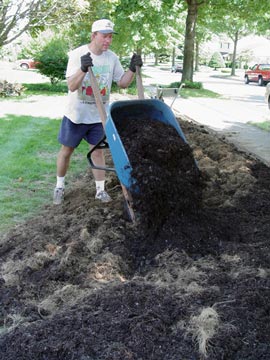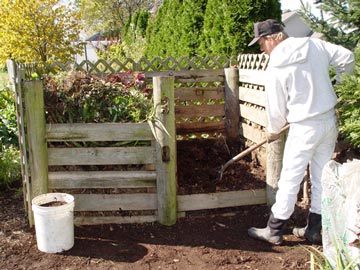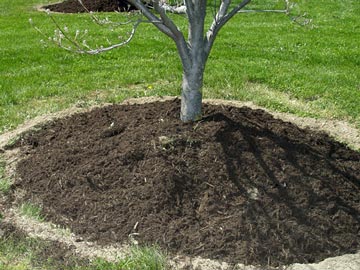 Compacted or poorly drained soil is best loosened and improved before planting.
Compacted or poorly drained soil is best loosened and improved before planting.
© George Weigel
Preventing problems in the landscape is much easier – and less expensive – than reacting to trouble after it happens. Treating for bugs, trying to control diseases, and replacing dead or struggling plants is a lot of work. Here are 8 tactics to head off that kind of unwelcome work in your yard-care regimen:
1. Good plants, right spot.
Some plants are more likely to run into bug and disease trouble than others. Dwarf Alberta spruce (mites), euonymus (scale), dogwood (anthracnose), impatiens (downy mildew), and hybrid tea roses (a little bit of everything) are examples of common plants with common problems. It’s worth doing the homework to learn the key potential problems with plants in your area, and better yet, ones that seldom run into trouble. Local professionals know these well, so consult with resources such as Master Gardeners, garden-center staffers, Extension Service educators, and even experienced local gardeners. Online plant lists and regional plant books also are well worth the investment. Once you zero in on the best choices, get them in the proper place, i.e. sun-lovers in sun, damp-preferrers in wet spots and so on.
2. Improve the soil.
Many gardeners are faced with planting in yards that were heavily graded before construction. That soil tends to be compacted and layered, which is terrible for drainage and root growth. Even native soil can often be too clayish, too rocky or too sandy. Most plants grow best in loose, well drained and reasonably nutritious soil, which may require some adjustment to bring to optimal levels. If you’re lucky enough to have decent soil, you can just dig and plant. But if you’re dealing with compacted or poor-quality soil, consider improving it before planting. A good strategy is to loosen the soil to at least 10-12 inches, and work in an inch or two of compost, rotted leaves, bagged planting mix from the garden center or similar organic matter. The result will be slightly raised planting beds.
 Composting is not only a good way to recycle organic yard waste, but the finished product adds nutrition, organic matter, and disease-fighting properties to planting beds.
Composting is not only a good way to recycle organic yard waste, but the finished product adds nutrition, organic matter, and disease-fighting properties to planting beds.
© George Weigel
3. Make your own compost.
First, composting is an excellent way to recycle leaves, grass clippings, kitchen peelings and other organic household waste. Second, the result is the best product for improving garden soil (see above) and for adding nutrition by topping it on existing beds or the lawn. Third, compost has natural disease-fighting properties, not to mention a multitude of microbes that benefit the living ecosystem that your soil should be.
4. Plant at the right depth.
Too-deep planting is a leading cause of tree death. Sometimes plants end up too deep from settling in over-dug holes, but most of the time the plants are just set too deep at planting. Buried trunks are prone to rotting, and deeply set root systems suffer from lack of oxygen. Container-grown shrubs and perennials are easy to figure out since you can usually plant at the same depth that the rootball was growing in the pot. But for trees, it’s important to locate the “root flare” – the point at the base of the trunk where the wood widens out and the roots begin. That point needs to be placed slightly above grade. You might even need to remove some of the soil from around your tree’s base to find the flare. Planting too high is also bad if roots are exposed to drying air above ground. If that’s the case, you’ll need to deepen the hole or tamp a heaved-up rootball back down or cover the exposed roots with 2-3 inches of mulch (no more).
 Some mulch is good for retaining soil moisture and choking weeds, but mulch packed up onto tree bark can rot the bark and potentially kill the tree.
Some mulch is good for retaining soil moisture and choking weeds, but mulch packed up onto tree bark can rot the bark and potentially kill the tree.
© George Weigel
5. No excess mulch.
Piling on the mulch has the same effect as planting too deeply. One to 2 inches is ideal around flowers, and 2 to 3 inches is enough around shrubs and trees. Don’t keep adding more mulch every year unless the old mulch is decaying to below those amounts. Eight inches of mulch will stop weeds nicely, but it’ll also stunt or kill your plants. Also, keep mulch a few inches back away from trunks and stems to discourage rotting.
6. Water the ground, not the plants.
The main problem with watering over top of plants is that most plant diseases thrive on damp leaves. You can also lessen the odds of plant disease by thinning out overly dense trees and shrubs and by dividing perennial beds that are too crowded. Densely packed canopies impede air flow that helps dry out leaves and head off moisture-fed disease. If you must water over top of plants, at least do it in early morning (the best time for leaves to dry) or early evening (so leaves aren’t wet going into the slow-drying overnight hours).
7. Fertilize properly.
More isn’t better. Research has found that over-fertilized plants are often more attractive to bugs, probably because there’s more nutrition available. The goal is to give plants soil that provides them with optimal nutrients. Soil lacking in key nutrients hurts plant health, but soil that’s excessive in one or more nutrients or out of whack altogether from over-fertilization isn’t helpful either. Poorly performing or poorly colored plants are clues that something could be amiss nutrition-wise. If you’ve never done it (or haven’t done it in awhile), invest in a do-it-yourself soil test. Those are available through most Extension services, land-grant universities and garden centers. Test results will tell you what to add and in what amounts. Otherwise, you’re just guessing.
8. Pay attention.
It’s much easier to solve a pest or disease problem when you catch it early. That doesn’t mean spray the whole yard at the first sign of a bug crawling on a leaf, but it does mean monitoring your plants. Know what your plants normally look like (or should look like), and assess whether there’s a problem brewing if that changes. A lot of bug and disease problems are temporary and/or cosmetic that can be ignored or treated by something simple, such as a swift blast of hose water or picking off the leaves of an early disease threat. If what you see looks like more than just a temporary or cosmetic matter, research the most targeted and least disruptive way of dealing with that particular problem.